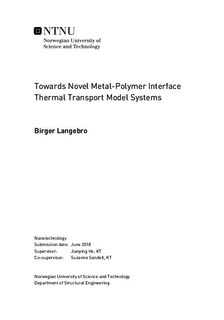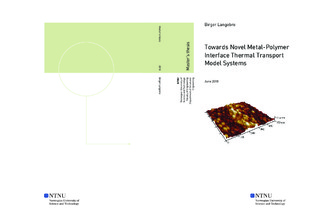| dc.description.abstract | Enhanced control of thermal transport through metal-polymer interfaces is in demand as metal-polymer composites and organic electronics proliferate while continuous component miniaturization is pursued.
Thermal conductivity of polymers is low, therefore thermal boundary conductance (TBC), describing the added resistance of interfaces, only becomes important when polymer component dimensions reach the nanometer scale.
TBC is an elusive quantity to measure, requiring advanced experimental setups coupled to system-wide simulations of precisely defined model systems with the mentioned dimensions.
Such model systems, for use in three different thermal characterization methods were developed and accurately characterized in this thesis work.
The three targeted characterization techniques 3-omega, frequency domain thermoreflectance, and quasi-static thermal flow, all imposed different constraints on their respective model systems resulting in a total of five different suggested model systems.
Three model systems were successfully fabricated, and proofs of concept were given for the remaining two using a combination of spin-coating, dry etching and sputter coating as fabrication methods. %of predominantly Si, Au and poly(methyl methacrylate) (PMMA).
In addition, efficient and reliable methods for characterizing thickness, thickness uniformity, sub-nanometer surface roughness, bulk structure and polymer orientation using white light interferometry, \textmu-Raman spectroscopy, atomic force microscopy (AFM), scanning electron microscopy (SEM) and scotch-tape adhesion testing were developed, and results were verified to be in accordance with published literature.
Noticeably, a gentle and rapid method for smooth step edge fabrication was developed, metal interface structures of a metal film peeled from a polymer substrate were mapped using AFM, and a free-standing poly-methyl methacrylate (PMMA) thin film was achieved through release from a poly(vinyl alcohol) (PVA) layer in water.
From completed model systems it was learned that sputtered Au adhered poorly to both as-received and spincoated PMMA.
On the other hand, spincoated polymer adhered strongly to all substrates, indicating large interface differences, which were confirmed by AFM characterization of interfacial voids in the sputtered Au film.
The bulk composition of metal films was found to consist of columnar grains, based on AFM nanomechanical mapping of metal surfaces for a range of different film thicknesses.
Polymer bulk composition was found to not be affected by the spincoating process.
Important steps have been made in fabricating and understanding these metal-polymer model systems, but work on accurate interface characterization still remains.
It must also be verified that the chosen geometries can yield accurate TBC values in thermal conductivity measurements. | |

